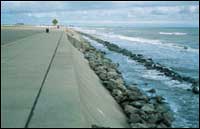|
 |
|
 |
 |
| Physical Agents of Land Loss: |
|
|
 |
|
 |
|
 |
|
|
 |
|
 |
|
 |
 |
| Role of Shoreline Characteristics: |
|
 |
|
 |
|
|
 |
|
 |
 |
| Role of Human Activities: |
|
 |
|
 |
|
 |
| Coastal Construction |
 |
|
 |
|
 |
|
 |
|
 |
|
|
 |
|
 |
|
 |
|
 |
|
|
 |
Role of Human Activities: Coastal Construction
 |
| Figure 10. Hard structures, such as the Galveston seawall, can increase erosion of adjacent beaches. [larger version] |
Engineering structures such as groins, breakwaters, seawalls/bulkheads, and revetments are designed to control coastal land loss, but they can accelerate land loss of adjacent beaches (Fig. 10, Morton, 1988b) by changing wave refraction patterns and depleting sand supply. Shore-parallel structures cause erosion by narrowing the beach as the shoreline retreats. Some shore-normal structures contribute to erosion by either trapping sand that would normally move alongshore or directing the sediment-laden currents offshore causing permanent losses of beach sand.
Seawalls and bulkheads can contribute to incomplete storm beach recovery by limiting the onshore transportation and deposition of sand. The structures can decrease the effective width of dry beach needed for eolian transport and prevent the progressive transfer of sand from the forebeach to the backbeach. As a result of this interference with the sand budget, natural dune restoration is prevented or prolonged and the total beach recovery is either incomplete or delayed.
continue to River Modification
 |



